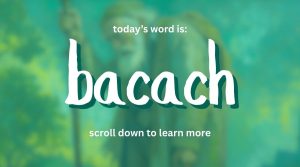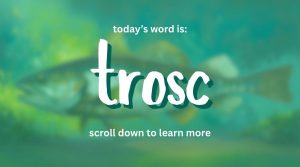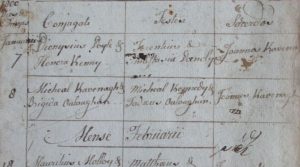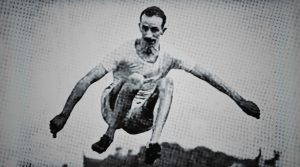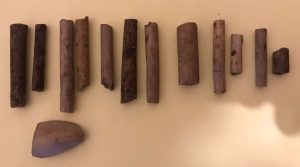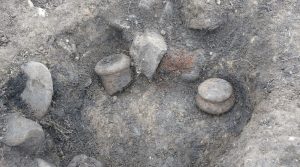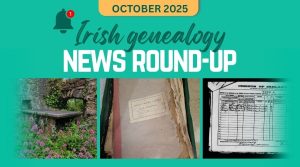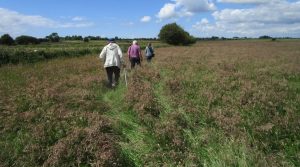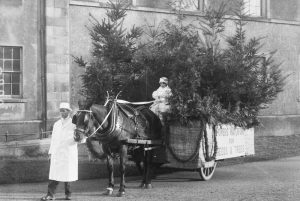Each week, SAY IT IN IRISH features an Irish or Hiberno-English word or phrase, exploring its meaning, history and origins – with an audio recording by a native Irish speaker from Cork so you can hear how it’s pronounced.
Crónán
Today’s word is crónán – an Irish term that refers to the act of humming, murmuring, crooning, buzzing, purring, droning and, in certain contexts, chanting or moaning. At its simplest, it describes a dull, prolonged note or a continuous, sleepy hum. It can be used for natural sounds: the lapping of waves, the babble of a river, the boom of a waterfall, the buzzing of insects, the purring of a cat or the bellowing of cattle. It can also be used for manmade noises: the drone of a bagpipe, a kettle boiling, a steam engine rumbling or any low humming air or song.
A D V E R T I S E M E N T
You can find it used in phrases such as crónán na sruthán (the babbling of the streams), crónán píbe (the drone of a pipe) and crónán cait (the purr of a cat). There’s even a seanfhocal (old saying or proverb) that goes: Ar mhaithe leis féin a dheineann an cat crónán, meaning it’s for the cat’s own good that he purrs.
The word is a diminutive of the Irish crón, meaning a hum, with its own diminutive being crónáinín. In Hiberno-English, it sometimes appears as “cronaun” or “croonaun” and may be related to the English verb “croon”.
Say “humming” in Irish: crónán
Crónán – pronounced roughly kroh-nawn (with the emphasis on the last syllable in Munster Irish)
Press play to hear the pronunciation:
Music and performance
Historically, the term crónán was not confined to background sounds but extended to vocal and musical practices as well. The term and its derivatives appear in numerous medieval Irish texts. For example, a Middle Irish gloss to Uraicecht Becc, a legal tract on status, lists crónánaig – performers of crónán or hummers – alongside fedánaig (flute or pipe players) among the fo-dána, subordinate performers of the “base arts” whose honour-price depended on that of their patrons. They were ranked with jugglers, buffoons and clowns. In this hierarchy, the only entertainer accorded his own honour-price was the harper.
Sign up to our newsletter
The late medieval Book of Lismore preserves a poem attributed to the legendary Fianna warrior Caoilte mac Rónáin, nephew of Fionn mac Cumhaill. While resting at a cairn called Letir Dubh in Co. Kerry, Caoilte listens to the music of local herdsmen and shepherds and records in verse the names of the different types of music he hears. Among them is the crónán.
>>> YOU MIGHT ALSO LIKE: The messenger, the romantic and the loyal hound: Fianna tales of Caoilte, Diarmaid and Bran
But what did the crónán sound like? In 1786, the Dublin-born antiquary Joseph Cooper Walker described it as “a tune hummed in a low key”. Irish scholar and antiquary Eugene O’Curry, writing in 1873, described it as “a sort of musical purring, a throat accompaniment without words”. He added:
“I have, myself, often heard with pleasure this crónán, or throat accompaniment, without words, performed to old Irish dirges; and I very well know how it was produced, and could even attempt an imitation of it. But, I have never heard the cronán fully sung in concert; and I have known only two men who were proficients in it; one of them was my own father; the other was John Molony, a younger and better performer. They were both large men… There may be many persons still living in various parts of Ireland, who have heard this crónán from their fathers; and there may be some who can produce it…”
A D V E R T I S E M E N T
According to O’Curry, a cronunuighe was the name for a professional musician who performed the crónán. Simon O’Dwyer of Ancient Music Ireland has experimented with reconstructing this type of music. He interprets the crónán as a guttural droning, a form of overtone singing that enhances a melody and enriches the texture of a performance. Below, press play on the video to listen to Simon accompanying sean-nós singer Caitríona Ní Cheannabháin from Galway as she performs “Caoineadh na dTrí Muire”.
Although we can never know for sure how the crónán sounded, surviving descriptions, coupled with the way Simon’s monotonous droning complements a melody, suggest it could have resembled the performance above.
A few weeks ago, we looked at the Irish word bacach, meaning “lame” but later used to refer to professional “beggars” – and we noted that these beggars were known for a special type of crónán.
>>> YOU MIGHT ALSO LIKE: Say “beggar” in Irish: bacach
Professional bacachs roamed the countryside, exchanging stories and news for food and lodging. They were a common sight at pilgrimage sites across Ireland on saints’ feastdays and holy days in the 18th and 19th centuries. One church site especially associated with professional bacachs was St Gobnait’s in Ballyvourney, Co. Cork. In return for alms, bacachs performed a particular crónán, or chant, believed to have healing powers. Their reputation was such that they drew large crowds from far and wide. The most accomplished were presented with a blackthorn stick studded with brass nails – the number of nails signifying the potency of his crónán and, by extension, his healing abilities.
>>> YOU MIGHT ALSO LIKE: St Gobnait: patron saint of ironworkers, beekeepers and Ballyvourney
But it was not only beggars who made use of the power of the crónán. In 1922, Alexander Martin Freeman, an English historian and musician married to a Donegal woman, published “Crónán na Bó” (The Cow’s Chant) in the Journal of the Irish Folk Song Society. A milking song sung by women, it was transcribed from a 1876 manuscript by collector and writer Proinnsias Ó Catháin (Francis Keane), with minor edits by Freeman.

Ó Catháin made the following remarks about it:
“The … peculiar old song or crónán was formerly sung in Ulster by women while milking cows; and it was a fact well-known among the peasantry that some cows would not give their milk except they were thus serenaded. This ancient custom is to this day practised in some remote districts of the West of Ireland.”
Please help support
Irish Heritage News
A small independent start-up in West Cork
Give as little as €2
Thank You
Names
Crónán was also a common personal name in medieval Ireland, though it is rare today (sometimes anglicized Cronan). Nearly 20 early saints of this name appear in the martyrologies, including the founders of church sites at Roscrea in Co. Tipperary and Tuamgraney in Co. Clare. The name appears to be a diminutive form of the Irish crón, meaning “tawny”, “swarthy” or “tanned” and whether there was ever a connection between the name and the practice of performing the crónán remains uncertain.
From this personal name came the surname Ó Cróinín, anglicized Cronin or occasionally Croneen, especially common in Co. Cork. The Ó Cróinín, a West Cork sept and part of the Corca Laoighdhe, were recorded as hereditary owners of territory to the west of Clonakilty and erenaghs of Gougane Barra.
A D V E R T I S E M E N T
Cronauning
The Irish term crónán passed into Hiberno-English as “cronauning”, meaning humming, muttering under one’s breath or even moaning. It can be used as follows: “Stop your cronauning and get on with the job!” and “The old woman was cronauning away in the corner”. James Joyce played with it in Finnegans Wake when he created the phrase “cremoaning and cronauning”. While the term “cronauning” is not particularly common in everyday speech in Ireland, it may still be used by some older people in Gaeltacht areas when speaking English.
Another variant, “croning”, is described by O’Curry as a shortened and misapplied form of “cronauning” and may also have been influenced by the English word “crone”, referring to an old woman often characterized as being disagreeable or malicious.
Say “cronauning” in Hiberno-English:
Cronauning – pronounced roughly kroh-nawn-ing
Press play to hear the pronunciation:
READ NOW
➤ Limerick company Bitesize Irish launches online course teaching traditional Irish songs
➤ Leap year dances in Ireland 100 years ago




